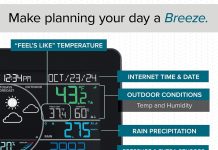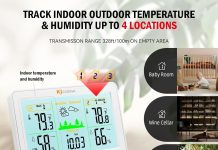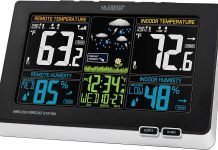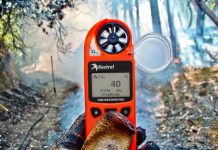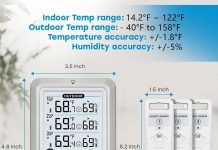We all know the importance of keeping track of the weather outside our homes, but what about the conditions inside? That’s where home weather stations come in. These handy devices are not only able to provide accurate and up-to-date information about the temperature, humidity, and air quality outdoors, but they can also monitor the conditions inside our homes. With their advanced sensors and user-friendly interfaces, home weather stations are becoming a popular tool for homeowners looking to maintain a comfortable and healthy living environment. Let’s take a closer look at how these innovative devices can help us better understand and monitor our indoor conditions.
Review contents
Overview
What are home weather stations?
Home weather stations are devices that allow individuals to track and monitor weather conditions both indoors and outdoors. These stations are equipped with various sensors that measure temperature, humidity, air pressure, wind speed, and other environmental variables. The data collected by these sensors can be accessed in real-time, providing users with accurate and up-to-date information about their surrounding climate.
Why monitor indoor conditions?
Monitoring indoor conditions is essential for creating a comfortable and healthy living environment. Indoor temperature, humidity, and air quality directly impact our well-being and overall quality of life. By understanding and tracking these factors, we can make informed decisions to improve our comfort, energy efficiency, and address potential issues before they become significant problems.
Can home weather stations monitor indoor conditions?
Yes, home weather stations have the capability to monitor indoor conditions. While their primary function is to provide outdoor weather information, many modern weather stations now include indoor sensors to give users a more comprehensive understanding of their environment. These indoor sensors measure temperature, humidity, and air quality, allowing homeowners to track and manage indoor climate alongside outdoor weather conditions.
Features of Home Weather Stations
Outdoor weather monitoring
One of the primary features of home weather stations is their ability to monitor and provide real-time information about outdoor weather conditions. This includes variables such as temperature, humidity, air pressure, wind speed, and rainfall. By continuously keeping track of these factors, users can stay informed about changing weather patterns and plan their activities accordingly.
Indoor climate tracking
In addition to outdoor weather monitoring, home weather stations now offer the capability to track indoor conditions. With dedicated sensors placed strategically inside the home, these weather stations can measure temperature, humidity, and air quality. This indoor climate tracking provides users with valuable insights into their indoor environment, helping them create a more comfortable living space.
Real-time data collection
Home weather stations collect data from various sensors and provide real-time information to the users. This means that individuals can have instant access to the current weather conditions both indoors and outdoors. Real-time data collection enables homeowners to make informed decisions based on up-to-date information, whether it’s adjusting the thermostat, opening windows, or planning outdoor activities.
Monitoring Indoor Conditions with Home Weather Stations
Temperature monitoring
Temperature monitoring is a crucial aspect of indoor climate control. Home weather stations equipped with indoor sensors can provide accurate real-time temperature readings, allowing users to monitor temperature fluctuations throughout the day. This information is valuable as it helps individuals adjust heating or cooling systems to maintain a comfortable indoor environment.
Humidity monitoring
Humidity levels greatly impact our comfort and health. High humidity can lead to a clammy and stuffy atmosphere, while low humidity can cause dryness and discomfort. Home weather stations with indoor sensors track humidity levels, enabling users to assess and adjust their indoor environment accordingly. By monitoring humidity, individuals can ensure a balanced and healthy living space.
Air quality monitoring
Indoor air quality is equally essential for our well-being. Poor air quality can lead to allergies, respiratory issues, and discomfort. Home weather stations now have sensors that measure air quality parameters such as particulate matter, volatile organic compounds (VOCs), and carbon dioxide levels. Monitoring air quality allows individuals to take necessary actions, such as improving ventilation, using air purifiers, or reducing pollutant sources.
Advantages of Indoor Monitoring with Home Weather Stations
Improved comfort and health
By monitoring indoor conditions with home weather stations, individuals can enhance their comfort and overall well-being. They can adjust heating and cooling systems based on real-time temperature readings, ensuring a comfortable indoor environment throughout the day. Tracking humidity levels helps prevent issues like dry skin or mold growth, while monitoring air quality helps create a healthier living space free from pollutants.
Energy efficiency
Monitoring indoor conditions with home weather stations promotes energy efficiency. By having a clear understanding of temperature patterns, homeowners can optimize their heating and cooling systems to avoid unnecessary energy consumption. Adjusting temperature settings based on real-time data can lead to significant energy savings and lower utility bills. Additionally, monitoring and managing humidity levels can help prevent excessive use of humidifiers or dehumidifiers.
Detection of hidden issues
Home weather stations provide valuable insights into the indoor environment, allowing individuals to detect hidden issues that may not be immediately apparent. By tracking temperature, humidity, and air quality trends, users can identify potential areas of concern such as moisture accumulation, mold growth, or poor ventilation. Detecting these issues early on allows for timely intervention, preventing further damage to the property and safeguarding occupants’ health.
Choosing the Right Home Weather Station
Accuracy and reliability
When choosing a home weather station, it is crucial to prioritize accuracy and reliability. Look for well-established brands with a reputation for providing accurate and consistent data. Read customer reviews and compare different models to ensure the station you choose will provide reliable information.
Compatibility with indoor sensors
If indoor monitoring is a priority, select a home weather station that includes indoor sensors or has the capability to connect with compatible indoor sensors. Ensure that the station and sensors work seamlessly together to provide accurate and comprehensive data about both outdoor and indoor conditions.
Ease of use and installation
Consider the ease of use and installation when selecting a home weather station. Look for stations with user-friendly interfaces and easy setup processes. Check if the station offers mobile app compatibility for convenient access to data. Consider the installation requirements, including mounting options and sensor placement, to ensure it suits your specific needs.
Installing and Setting Up Indoor Sensors
Placement recommendations
Proper placement of indoor sensors is crucial for accurate readings. Follow the manufacturer’s recommendations for sensor placement to ensure reliable data. Generally, sensors should be placed in areas that reflect the overall indoor environment, away from direct sunlight, drafts, or sources of heat that could affect the readings.
Calibration and synchronization
Before using the indoor sensors, calibrate them according to the manufacturer’s instructions to ensure accurate readings. Calibration may involve adjusting settings or zeroing the sensor. Additionally, synchronize the indoor sensors with the main weather station to establish a reliable connection and ensure seamless data transmission.
Connecting sensors to the main station
Once the sensors are installed and calibrated, connect them to the main weather station following the provided instructions. This typically involves pairing the sensors wirelessly or via a wired connection. Ensure that the connection is established correctly to enable the transmission of indoor data to the main station.
Interpreting and Utilizing Indoor Readings
Understanding temperature and humidity levels
Interpreting indoor temperature and humidity readings allows individuals to create a comfortable and healthy living environment. Ideal temperature ranges from 68 to 72 degrees Fahrenheit, while humidity levels should fall between 40% and 60% for optimal comfort. By monitoring temperature and humidity trends, users can adjust HVAC settings and use humidifiers or dehumidifiers to maintain desired levels.
Analyzing air quality data
Analyzing air quality data provided by home weather stations is essential for creating a healthy indoor environment. Pay attention to particulate matter (PM) levels, VOC concentrations, and carbon dioxide (CO2) levels. PM levels should ideally be low, while VOCs and CO2 levels should be within acceptable ranges. Take appropriate actions based on the data, such as ventilating the space, using air purifiers, or reducing pollutant sources.
Taking action based on readings
Home weather stations provide actionable data that users can use to improve their indoor environment. Use temperature and humidity readings to adjust heating and cooling systems, ensuring comfort without unnecessary energy consumption. If air quality readings indicate poor conditions, take appropriate steps to improve ventilation, reduce pollutants, or use air filtration systems. Use the data collected by the weather station to make informed decisions and create a healthier living space.
Potential Challenges and Limitations
Sensor precision limitations
While home weather stations generally provide accurate data, it’s important to be aware of potential limitations in sensor precision. Certain factors may affect the accuracy of readings, such as sensor calibration, environmental conditions, or interference. Regularly calibrating sensors, following placement recommendations, and cross-checking with other reliable sources can help mitigate potential precision limitations.
Maintenance and calibration
Maintenance and calibration are essential for ensuring accurate readings and proper functionality of home weather stations. Follow the manufacturer’s guidelines for regular maintenance tasks such as cleaning sensors, replacing batteries, or updating firmware. Additionally, routinely calibrate the sensors according to the provided instructions to maintain accuracy over time.
Interference and connectivity issues
Interference or connectivity issues may arise when using home weather stations, affecting data transmission or sensor performance. Wireless stations may experience interference from other devices or limitations of Wi-Fi networks. If connectivity issues persist, consider troubleshooting steps such as checking network settings, relocating the station or router, or contacting customer support for assistance.
Integration with Smart Home Systems
Syncing with mobile apps
Many home weather stations offer mobile apps that allow users to access and monitor their indoor and outdoor data conveniently. These apps provide real-time information, historical data, and customizable alerts. Syncing the weather station with a mobile app enhances the user experience and provides easy access to all the information from anywhere.
Automating indoor climate control
Home weather stations can integrate with smart home systems to automate indoor climate control. By connecting the weather station to other smart devices such as thermostats, users can create rules that automatically adjust temperature settings based on specific triggers or data thresholds. This automation ensures a comfortable indoor environment without constant manual adjustments.
Integration with voice assistants
Some advanced home weather stations can integrate with voice assistants like Amazon Alexa or Google Assistant. This allows users to access weather data and control indoor climate simply by using voice commands. Voice integration adds convenience and hands-free control to managing indoor conditions, making it even easier to create a comfortable living space.
Conclusion
Home weather stations are not just limited to monitoring outdoor weather conditions; they also have the capability to track and monitor indoor conditions. By investing in a home weather station with indoor sensors, individuals can enhance their comfort, health, and energy efficiency. With the ability to monitor temperature, humidity, and air quality, home weather stations provide valuable insights that allow users to make informed decisions and create a healthier and more desirable indoor environment. Choose a reliable and compatible station, follow installation guidelines, interpret the data collected, and take proactive steps to optimize your indoor conditions. With a home weather station, you can stay informed, comfortable, and create a better living space for yourself and your loved ones.


